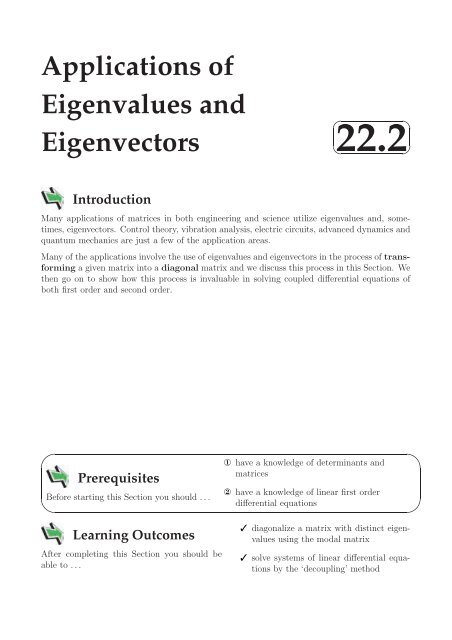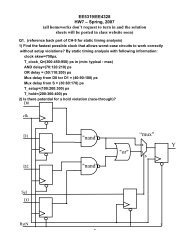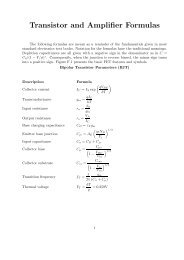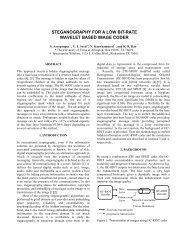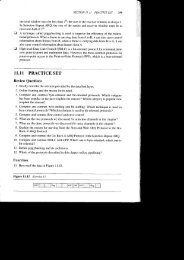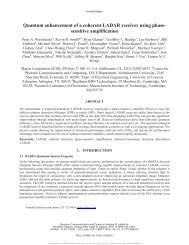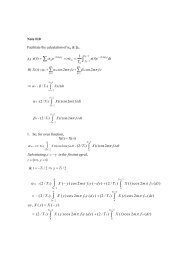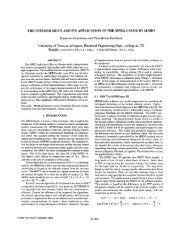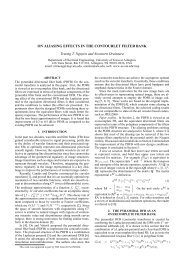Applications of Eigenvalues and Eigenvectors
Applications of Eigenvalues and Eigenvectors
Applications of Eigenvalues and Eigenvectors
- No tags were found...
You also want an ePaper? Increase the reach of your titles
YUMPU automatically turns print PDFs into web optimized ePapers that Google loves.
<strong>Applications</strong> <strong>of</strong><strong>Eigenvalues</strong> <strong>and</strong><strong>Eigenvectors</strong>✓✏22.2✑✒IntroductionMany applications <strong>of</strong> matrices in both engineering <strong>and</strong> science utilize eigenvalues <strong>and</strong>, sometimes,eigenvectors. Control theory, vibration analysis, electric circuits, advanced dynamics <strong>and</strong>quantum mechanics are just a few <strong>of</strong> the application areas.Many <strong>of</strong> the applications involve the use <strong>of</strong> eigenvalues <strong>and</strong> eigenvectors in the process <strong>of</strong> transforminga given matrix into a diagonal matrix <strong>and</strong> we discuss this process in this Section. Wethen go on to show how this process is invaluable in solving coupled differential equations <strong>of</strong>both first order <strong>and</strong> second order.★✧PrerequisitesBefore starting this Section you should ...Learning OutcomesAfter completing this Section you should beable to ...1 have a knowledge <strong>of</strong> determinants <strong>and</strong>matrices2 have a knowledge <strong>of</strong> linear first orderdifferential equations✓ diagonalize a matrix with distinct eigenvaluesusing the modal matrix✓ solve systems <strong>of</strong> linear differential equationsby the ‘decoupling’ method✥✦
1. <strong>Applications</strong> <strong>of</strong> <strong>Eigenvalues</strong> <strong>and</strong> <strong>Eigenvectors</strong>Diagonalization <strong>of</strong> a Matrix with distinct eigenvaluesDiagonalization means transforming a non-diagonal matrix into an equivalent matrix which isdiagonal <strong>and</strong> hence is simpler to deal with.A matrix A with distinct eigenvalues has, as we mentioned in property 3 in Section 22.1, eigenvectorswhich are linearly independent. If we form a matrix P whose columns are these eigenvectors,it can then be shown thatdet(P ) ≠0so that P −1 exists.The product P −1 AP is then a diagonal matrix D whose diagonal elements are the eigenvalues<strong>of</strong> A. Thus if λ 1 ,λ 2 ,...λ n are the distinct eigenvalues <strong>of</strong> A with associated eigenvectorsX (1) ,X (2) ,...,X (n) respectively:[]P =X (1) . X (2) . ··· . X (n)will produce a product⎡⎤λ 1 0 ... 0P −1 0 λ 2 ... 0AP = D = ⎢⎥⎣ .⎦0 ... ... λ nWe see that the order <strong>of</strong> the eigenvalues in D matches the order in which P is formed from theeigenvectors.N.B.(a) The matrix P is called the modal matrix <strong>of</strong> A(b) Since D, asadiagonal matrix, has eigenvalues λ 1 ,λ 2 ,...,λ n which are the same asthose <strong>of</strong> A then the matrices D <strong>and</strong> A are said to be similar. The transformation <strong>of</strong>A into D usingP −1 AP = Dis said to be a similarity transformation[ ] 2 3Example Let A = . Obtain the modal matrix P <strong>and</strong> calculate the product3 2P −1 AP . (The eigenvalues <strong>and</strong> eigenvectors <strong>of</strong> this particular matrix A wereobtained earlier in this workbook).HELM (VERSION 1: March 18, 2004): Workbook Level 222.2: <strong>Eigenvalues</strong> <strong>and</strong> <strong>Eigenvectors</strong>2
SolutionThe matrix [ A]has two distinct [ ] eigenvalues λ 1 = −1, λ 2 =5with corresponding eigenvectorsxxX 1 = <strong>and</strong> X−x2 = . We can therefore form the modal matrix from the simplestxeigenvectors <strong>of</strong> these forms:[ ]1 1P =−1 1[ ]2 3(Other eigenvectors would be acceptable e.g. we could use P =but there is no−2 3reason to over complicate the calculation).It is easy to obtain the inverse <strong>of</strong> this 2 × 2 matrix P <strong>and</strong> the reader should confirm that:P −1 =[1det(P ) adj(P )=1 21 1−1 1] T= 1 2[ 1 −11 1]We can now construct the product P −1 AP :∴ P −1 AP = 1 [ 1 −12 1 1[ 1 −1][ ][ 2 33 2][ ] −1 51 1−1 1]= 1 2 1 1= 1 [ −2 02 0 10[ ] −1 0=0 5]1 5[ as expected. ] Show(by repeating the method outlined above) that had we defined P =1 1(i.e. interchanged the order in which the eigenvectors were taken) we would find1 −1[ ] 5 0P −1 AP =(i.e. the resulting diagonal elements would also be interchanged).0 −1[ ] −1 4The matrix A =has eigenvalues −1 <strong>and</strong> 3 <strong>and</strong> associated eigenvectors<strong>and</strong> respectively.[ ] [0]31 10 1[ ] [ ] [ ]1 12 21 1If P 1 = , P0 12 = , P0 23 =1 0write down the productsP −11 AP 1 , P −12 AP 2 , P −13 AP 3(You may not need to do detailed calculations).3 HELM (VERSION 1: March 18, 2004): Workbook Level 222.2: <strong>Eigenvalues</strong> <strong>and</strong> <strong>Eigenvectors</strong>
Your solution[ −1 0]P1 −1 AP 1 =0 3= D 1[ −1 0]P2 −1 AP 2 =0 3= D 2P3 −1 AP 3 =[ 3 00 −1]= D 3Note that D 1 = D 2 , demonstrating that any eigenvectors <strong>of</strong> A can be used to form P . Note alsothat since the columns <strong>of</strong> P 1 have been interchanged in forming P 3 then so have the eigenvaluesin D 3 as compared with D 1 .Matrix PowersIf P −1 AP = D then we can obtain A as the subject <strong>of</strong> this matrix equation as follows:multiply on the left by P <strong>and</strong> on the right by P −1 to obtainPP −1 AP P −1 = PDP −1ButPP −1 = P −1 P = I∴ IAI = PDP −1 <strong>and</strong> so A = PDP −1We can use this result to obtain the powers <strong>of</strong> a square matrix, a process which is sometimesuseful in control theory. Note thatA 2 = A.A A 3 = A.A.A. etc.as we would expect: clearly obtaining high powers <strong>of</strong> A directly would involve many multiplications.The process is quite straightforward, however, for a diagonal matrix D.Obtain D 2 <strong>and</strong> D 3 if D =[ 3 00 −2].Write down D 10 .Your solutionHELM (VERSION 1: March 18, 2004): Workbook Level 222.2: <strong>Eigenvalues</strong> <strong>and</strong> <strong>Eigenvectors</strong>4
D 2 =D 3 =Continuing in this way: D 10 =[ 3 00 −2][ 3 00 −2]=[ ][ 320 3 00 (−2) 2 0 (−2)[ ]31000 (−2) 10[ ]3200 (−2) 2] [ ]330=0 (−2) 3We now use the relationA = PDP −1to obtain a formula for powers <strong>of</strong> A in terms <strong>of</strong> the easily calculated powers <strong>of</strong> the diagonalmatrix DA 2 = A.A =(PDP −1 )(PDP −1 )=PD(P −1 P )DP −1 = PDIDP −1 = PD 2 P −1Similarly:A 3 = A 2 .A =(PD 2 P −1 )(PDP −1 )=PD 2 (P −1 P )DP −1 = PD 3 P −1or, in general,A k = PD k P −1[ ] 2 3Example If A = find A3 223 .(Use the results <strong>of</strong> the worked example).Solution[We know from the previous worked example that if P =[ ] −1 0P −1 AP == D0 5where P −1 = 1 [ ] 1 −12 1 1∴ A = PDP −11 1−1 1∴ A 23 = PD 23 P −1 using the general result shown above[ ][ ][ ]1 1 −1 0 1 −1i.e. A =−1 1 0 5 23 1 1which is easily determined.]5 HELM (VERSION 1: March 18, 2004): Workbook Level 222.2: <strong>Eigenvalues</strong> <strong>and</strong> <strong>Eigenvectors</strong>
Exercises1. Find a diagonalising matrix P if⎡ ⎤[ ]1 0 04 2(a) A =(b) A = ⎣1 2 0⎦−1 12 −2 3Verify, in each case, that P −1 AP is diagonal, with the eigenvalues <strong>of</strong> A as its diagonalelements.Answers1. (a) P =[ −1 −21 1](b) P =⎡⎣1 0 0−1 1 0−2 2 1⎤⎦Systems <strong>of</strong> First Order Differential EquationsSystems <strong>of</strong> first order ordinary differential equations arise in many areas <strong>of</strong> mathematics <strong>and</strong>engineering, for example in control theory <strong>and</strong> in the analysis <strong>of</strong> electrical circuits. In each casethe basic unknowns are each a function <strong>of</strong> the time variable t. A number <strong>of</strong> techniques havebeen developed to solve such systems <strong>of</strong> equations; for example the Laplace transform or the use<strong>of</strong> the exponential matrix (outside the scope <strong>of</strong> this discussion). Here we shall use eigenvalues<strong>and</strong> eigenvectors to obtain the solution. Our first step will be to recast the system <strong>of</strong> ordinarydifferential equations in the matrix form Ẋ = AX where A is an n × n coefficient matrix <strong>of</strong>constants, X is the n × 1 column vector <strong>of</strong> unknown functions <strong>and</strong> Ẋ is the n × 1 column vectorcontaining the derivatives <strong>of</strong> the unknowns.. The main step will be to use the modal matrix <strong>of</strong>A to diagonalise the system <strong>of</strong> differential equations. This process will transform Ẋ = AX intothe form Ẏ = DY where D is a diagonal matrix. We shall find that this new diagonal system<strong>of</strong> differential equations can be easily solved. This special solution will allow us to obtain thesolution <strong>of</strong> the original system.Obtain the solutions <strong>of</strong> the pair <strong>of</strong> first order differential equations}ẋ = −2x(∗)ẏ = −5ygiven the initial conditionsx(0) =3 i.e. x =3 at t =0y(0) =2 i.e. y =2 at t =0(The notation is that ẋ = dxdt , ẏ = dydt )Recall, from your course on differential equations, that the general solution <strong>of</strong>the differential equation dydt = Ky is y = y 0e Kt .HELM (VERSION 1: March 18, 2004): Workbook Level 222.2: <strong>Eigenvalues</strong> <strong>and</strong> <strong>Eigenvectors</strong>6
Your solutionUsing the hint: x = x 0 e −2t y = y 0 e −5t where x 0 = x(0) <strong>and</strong> y 0 = y(0).From the given initial condition x 0 =3 y 0 =2 so finally x =3e −2t y =2e −5t .In the above example although we had two differential equations to solve they were really quiteseparate. We needed no knowledge <strong>of</strong> matrix theory to solve them.However, we should note that the two differential equations here can be written in matrix form.[ ] [ ] [ ]x ẋ−2 0Thus if X = Ẋ = A =yẏ0 −5the 2 equations (*) can be written as[ ] [ ][ ]ẋ −2 0 x=ẏ 0 −5 yi.e.Ẋ = AX.Write the pair <strong>of</strong> coupled differential equations}ẋ =4x +2yẏ = −x + yin matrix form.(∗∗)Your solution]][ xyẊ = AX4 2−1 1The essential difference between the two pairs <strong>of</strong> differential equations just considered is thatthe first pair (∗) were really separate equations, the first equation <strong>of</strong> (∗) involving only theunknown x, the second involving only y. In matrix terms this corresponded to a diagonalmatrix A in the system Ẋ = AX. The second system (∗∗) <strong>of</strong>equations were coupled in that[=][ ẋẏ7 HELM (VERSION 1: March 18, 2004): Workbook Level 222.2: <strong>Eigenvalues</strong> <strong>and</strong> <strong>Eigenvectors</strong>
oth equations involved both x <strong>and</strong> y. This corresponded to the non-diagonal matrix A inthe system Ẋ = AX.Clearly the second system here is more difficult to deal with than the first <strong>and</strong> there is wherewe can use our knowledge <strong>of</strong> diagonalisation.ExampleFind the solution <strong>of</strong> the coupled differential equationsẋ = 4x +2yẏ = −x + ywith initial conditions x(0) = 1 y(0) =0Here ẋ ≡ dxdt<strong>and</strong> ẏ ≡dydt .SolutionDefining as above[ ][ ]x(t)ẋX =<strong>and</strong> Ẋ = .y(t)ẏthe original system <strong>of</strong> differential equations can be written, as we have seen,[ ]4 2Ẋ = AX where A =in the present example.−1 1[ ] r(t)We now introduce a new column vector <strong>of</strong> unknowns Y = through the relations(t)X = PYwhere P is the modal matrix <strong>of</strong> A. Then, since P is a matrix <strong>of</strong> constants:Ẋ = P Ẏso Ẋ = AX becomes P Ẏ = AX = A(PY)Then, multiplying by P −1 on the left,Ẏ = (P −1 AP )YBut, because <strong>of</strong> the properties <strong>of</strong> the modal matrix, we know that P −1 AP is a diagonalmatrix. Thusifλ 1 ,λ 2 are distinct eigenvalues <strong>of</strong> A then:[ ]P −1 λ1 0AP =0 λ 2Hence Ẏ =(P −1 AP )Y becomes[ ] [ ][ ]ṙ λ1 0 r=.ṡ 0 λ 2 sHELM (VERSION 1: March 18, 2004): Workbook Level 222.2: <strong>Eigenvalues</strong> <strong>and</strong> <strong>Eigenvectors</strong>8
Solution (contd.)That is, when written out we haveṙ = λ 1 rṡ = λ 2 s.These equations are de-coupled. The first equation only involves the unknown function r(t)<strong>and</strong> has solution r(t) =Ce λ 1t . The second equation only involves the unknown function s(t)<strong>and</strong> has solution s(t) =Ke λ 2t where C, K are arbitrary constants.Once r, s are known the original unknowns x, y can be found from the relation X = PY.Note that the theory outlined above is applicable to any system <strong>of</strong> differential equations <strong>of</strong> theformẊ = AXwhere A is an n × n matrix with distinct eigenvalues λ 1 ,λ 2 ,...,λ n .Consider the present example in which[ ]4 2A = .−1 1It is easily [ checked ] that [ A has ] distinct eigenvalues λ 1 =3λ 2 =2<strong>and</strong> corresponding eigenvectors−2 1X 1 = ,X1 2 = . Therefore, if−1[ ][ ]−2 13 0P =then P1 −1−1 AP =0 2<strong>and</strong> (from above),Sor(t) =Ce 3t s(t) =Ke 2t .[ xy]≡ X = PY ===[ ][ ]−2 1 r1 −1 s[ ][ ]−2 1 Ce3t1 −1 Ke 2t[ ]−2Ce 3t + Ke 2tCe 3t − Ke 2t .9 HELM (VERSION 1: March 18, 2004): Workbook Level 222.2: <strong>Eigenvalues</strong> <strong>and</strong> <strong>Eigenvectors</strong>
Solution (contd.)Thereforex = −2Ce 3t + Ke 2ty = Ce 3t − Ke 2t .We can now impose the initial conditions x(0) = 1 <strong>and</strong> y(0) = 0 to give1 = −2C + K0 = C − K.Thus C = K = −1 <strong>and</strong> the solution to the original system <strong>of</strong> differential equations isx(t) = 2e 3t − e 2ty(t) = −e 3t + e 2t .The approach we have demonstrated in this example can be extended to(a) Systems <strong>of</strong> first order differential equations containing more than 2 unknowns(b) systems <strong>of</strong> second order differential equationsThe only restriction, as we have said, is that the matrix A in the system Ẋ = AX has distincteigenvalues.Systems <strong>of</strong> second order differential equationsThe ‘decoupling method’ discussed above can be readily extended to this situation which couldarise, for example, in a mechanical system consisting <strong>of</strong> coupled springs.Atypical example <strong>of</strong> such a system with two unknowns has the formẍ = ax + byÿ = cx + dyor, in matrix form,Ẍ = AX[ ] xwhere X =y[ a bA =c d], ẍ = d2 xdt 2 ,ÿ = d2 ydt 2[ ] r(t)Make the substitution X = PY where Y = <strong>and</strong> P is the modal matrixs(t)<strong>of</strong> A, A being assumed here to have distinct eigenvalues λ 1 <strong>and</strong> λ 2 . Solve theresulting pair <strong>of</strong> ‘decoupled’ equations for the case, which arises in practice,where λ 1 <strong>and</strong> λ 2 are both negative.HELM (VERSION 1: March 18, 2004): Workbook Level 222.2: <strong>Eigenvalues</strong> <strong>and</strong> <strong>Eigenvectors</strong>10
Your solutionExactly as with a first order system putting X = PY into the second order system Ẍ = AX[ ]Ÿ = P −1 AP Y that is Ÿ = DY D =giveswhere λ1 00 λ 2In full[ ¨r¨s]=[ ][λ1 0 r0 λ 2 s]That is, ¨r = λ 1 r = −ω 2 1r <strong>and</strong> ¨s = λ 2 s = −ω 2 2s(for the case where λ 1 <strong>and</strong> λ 2 are both negative.) The two uncoupled equations are <strong>of</strong> the form<strong>of</strong> the differential equation governing simple harmonic motion. Hence the general solutions arer = A cos ω 1 t + B sin ω 1 ts = C cos ω 2 t + E sin ω 2 tThe solutions for x <strong>and</strong> y are then obtained by use <strong>of</strong>X = PY.Note that in this second order case four initial conditions, two each for both x <strong>and</strong> y, arerequired because four constants A, B, C, E arise in the solution.11 HELM (VERSION 1: March 18, 2004): Workbook Level 222.2: <strong>Eigenvalues</strong> <strong>and</strong> <strong>Eigenvectors</strong>
Exercises1. Solve by decoupling each <strong>of</strong> the following systems:(a)[ ][dX3 41dt = AX where A = , X(0) =4 −33](b) ẋ 1 = x 2ẋ 2 = x 1 +3x 3ẋ 3 = x 2with x 1 (0) =2, x 2 (0) =0, x 3 (0) =2(c)⎡ ⎤⎡ ⎤2 2 11dXdt = ⎣1 3 1⎦ X with X(0) = ⎣0⎦1 2 20(d) ẋ 1 = x 1ẋ 2 = −2x 2 + x 3ẋ 3 =4x 2 + x 3with x 1 (0) = x 2 (0) = x 3 (0) =12. Matrix methods can also be used as we have discussed to solve systems <strong>of</strong> second-orderdifferential equations such as might arise with coupled electrical or mechanical systems.For example the motion <strong>of</strong> two masses m 1 <strong>and</strong> m 2 vibrating on coupled springs, neglectingdamping <strong>and</strong> spring masses, is governed bym 1 ÿ 1 = −k 1 y 1 + k 2 (y 2 − y 1 )m 2 ÿ 2 = −k 2 (y 2 − y 1 )where dots denote derivatives with respect to time. Write this system as a matrix equationŸ = AY <strong>and</strong> use the decoupling method to find Y if(i) m 1 = m 2 =1,k 1 =3,k 2 =2<strong>and</strong> the initial conditions are y 1 (0) =1,y 2 (0) = 2, ẏ(0) = −2 √ 6, ẏ 2 (0) = √ 6(ii) m 1 = m 2 =1, k 1 =6,k 2 =4<strong>and</strong> the initial conditions are y 1 (0) = y 2 (0) =0, ẏ 1 (0) = √ 2, ẏ 2 (0) =2 √ 2Verify your solutions by substitution in each case.HELM (VERSION 1: March 18, 2004): Workbook Level 222.2: <strong>Eigenvalues</strong> <strong>and</strong> <strong>Eigenvectors</strong>12
Answers1. (a)X =(c)X = 1 42. (i) Y =[ 2e5t− e −5te 5t + 2e −5t ]⎡⎣(b) X =⎤e 5t + 3e te 5t − e t ⎦ (d) X = 1e 5t − e t 5[ √cos t − 2 sin 6t2 cos t + sin √ 6t](ii) Y =⎡⎣2 cosh 2t4 sinh 2t2 cosh 2t⎡⎣[ √sin 2t2 sin √ 2t⎤⎦⎤5e t2e 2t + 3e −3t ⎦8e 2t − 3e −3t]13 HELM (VERSION 1: March 18, 2004): Workbook Level 222.2: <strong>Eigenvalues</strong> <strong>and</strong> <strong>Eigenvectors</strong>


